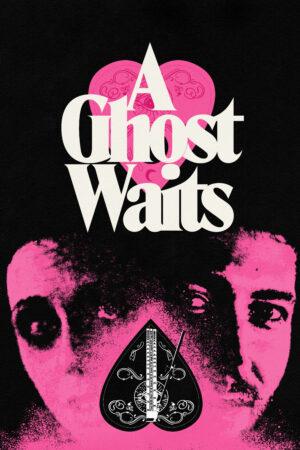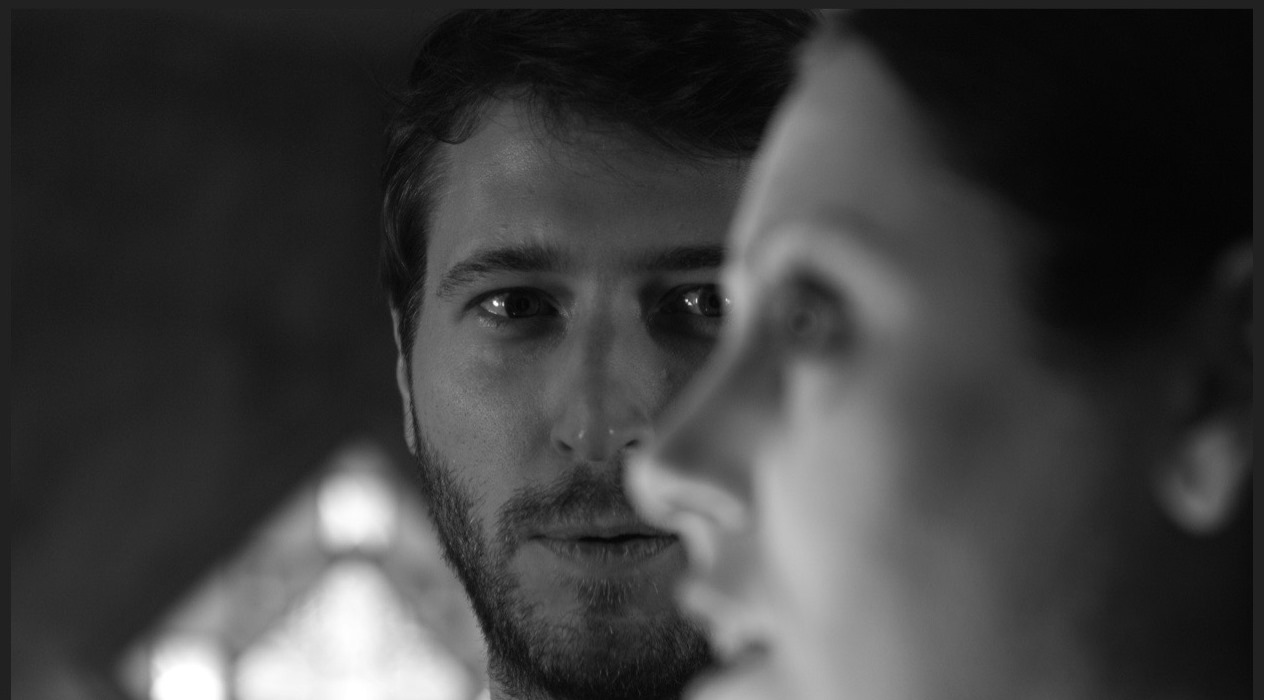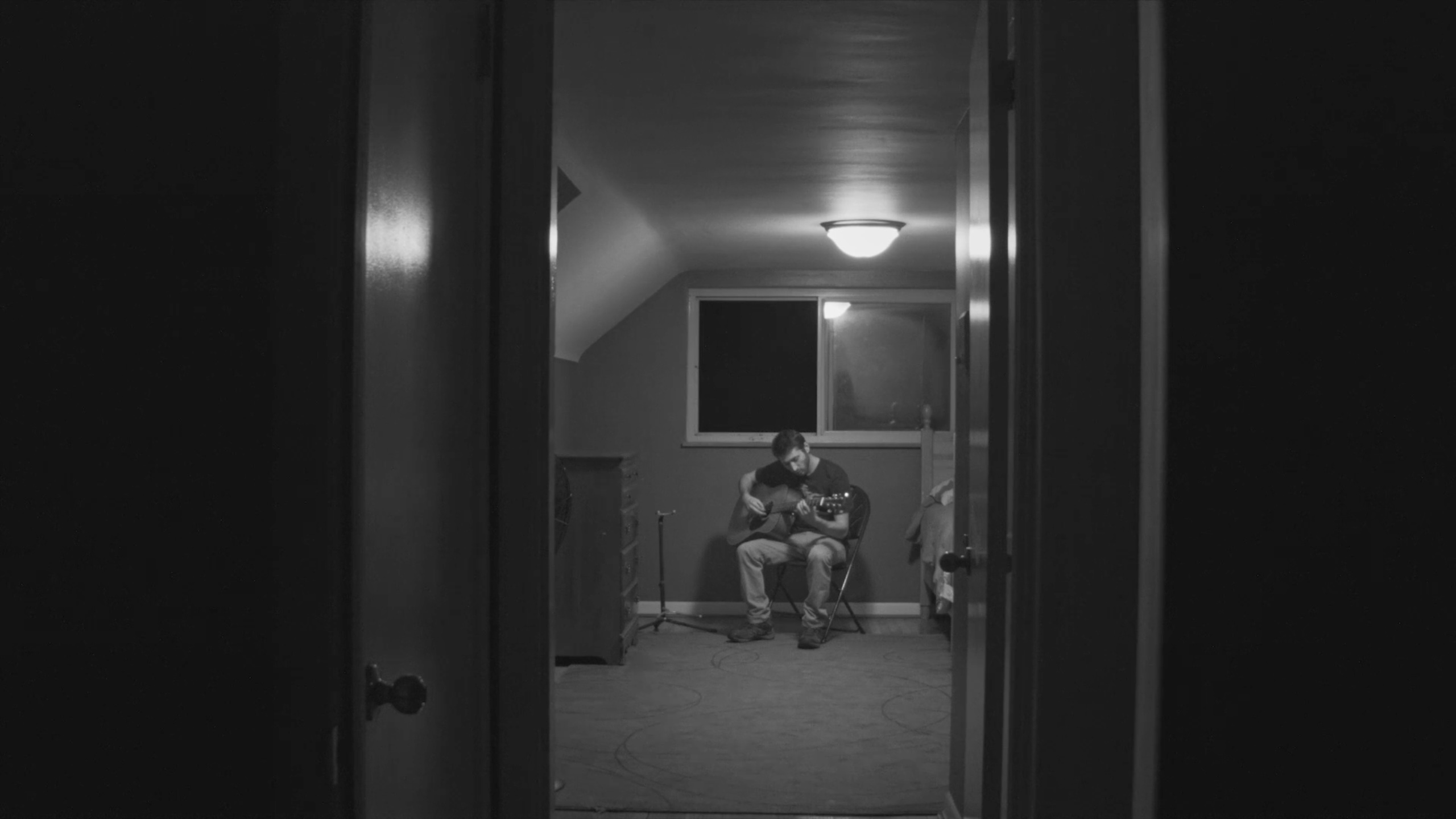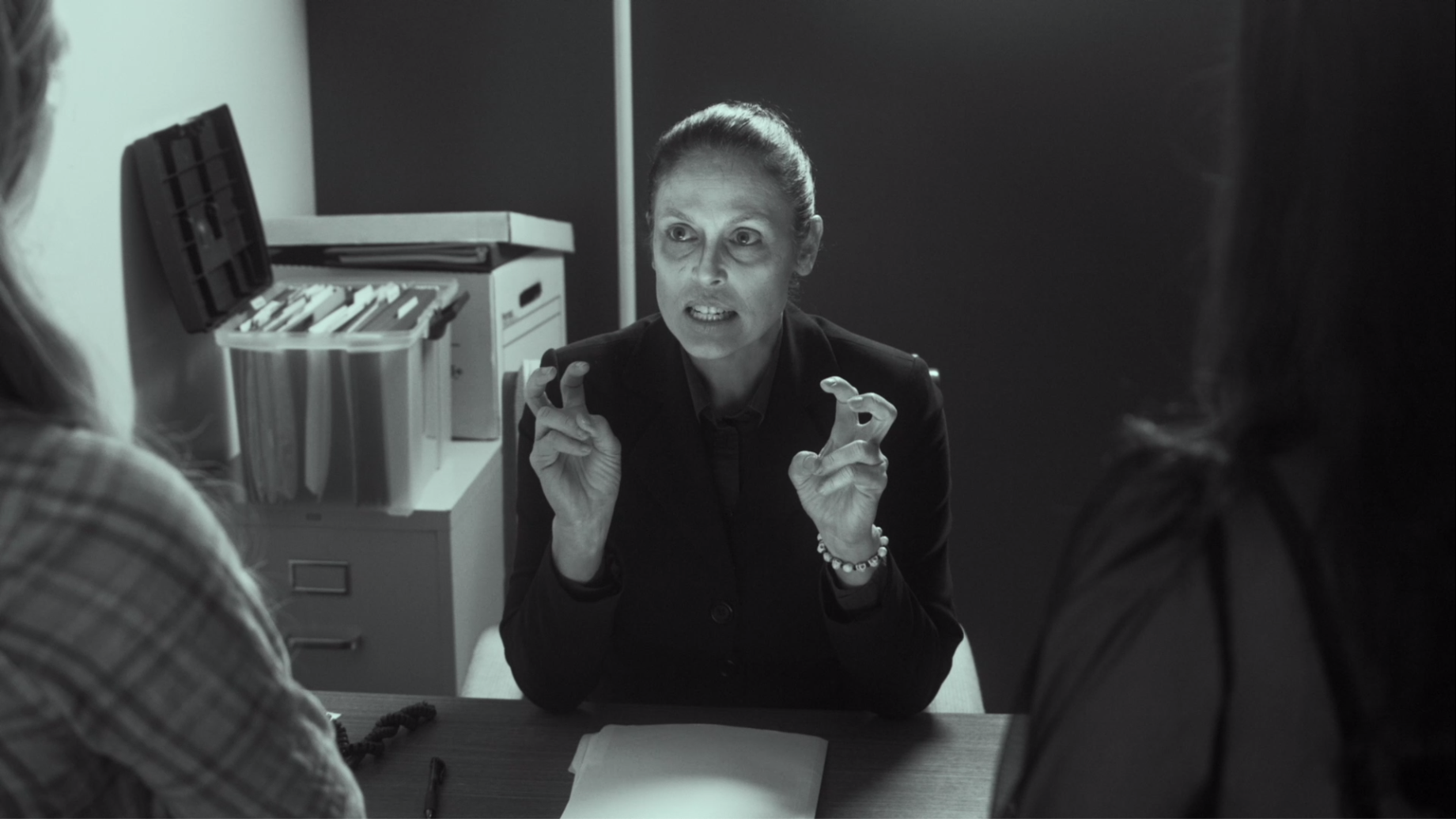
The debut feature from writer/director Adam Stovall, A Ghost Waits, now streaming via Arrow, follows on the heels of last year’s acquisition by the venerable genre company of another left-of-center, oddly quirky, black and white fun take on genre cinema, The Lake Michigan Monster. It’s exciting to see a company known for restoring classic films like Deep Red, Re-Animator, and more to glory turn to championing independent productions which attempt to do something more.
Therefore, it was a real joy to speak with Stovall, as well as the lead actor, Macleod Andrews (who was also a producer) about the making of this fun and emotionally-driven film.
“Tasked with renovating a neglected rental home, handyman Jack (Andrews) quickly finds out why the tenants keep leaving in droves – this house is haunted. The ghost in question is Muriel (Natalie Walker), herself employed from beyond the veil to keep the home vacant. Against the odds, Jack and Muriel find they have a lot in common… pulse notwithstanding. Having found a kindred spirit in an otherwise lonely existence, they must fight for their newfound affection as pressure mounts for them each to fulfill their ‘cross-purposes.’”
Scene-Stealers: I keep seeing this described as a “years in the making” film. Exactly how long did it take to get it made?
Adam Stovall: I had the idea in like autumn 2015. And we finished it – as in stopped working on it – in last December, because it took about five years. Took about five years to make this baby.

What was the reason behind that?
Adam Stovall: We have no money. Yeah. It costs money. That’s a glib answer, but you know, it was that: it was the fact that we were doing everything ourselves. And also, it just took time to find the movie. We shot it in August 2016 and then, when I cut together the assembly, it was an hour and 50 minutes. It was not good. I mean, assembly cuts are pretty much never good, but it was like, “Okay, the ending works, but good Lord – the rest of it?”
Then, as we edited and as tinkered with it and and everything, suddenly it was like, “Oh, this seems really good.” We got it to a point where like, from minute 34 – basically from the moment Muriel enters the film on – it worked, but we hadn’t really earned it in the previous 33 minutes. So then, we had to go back and we had two sets of pickups to, to go back and like re-imagined the first act.
I don’t know if you’ve ever heard the story of Breaking Bad: the writers’ strike happened and forced them to hit pause and they took that time to look back through what they had done and decided not to kill Jesse Pinkman and it became this thing where – whenever they wrote themselves into a corner – they just looked at the show that they’d made and they would inevitably find something that was like, “Oh, you know what, we can use this.”
Then, it’s paying off stuff and it feels like we did it on purpose. We were re-imagining the first act and we were taking cues from what worked in the second and third – not that this is really a three-act structure – but we were taking cues from what worked later in the film. You know: payoffs that didn’t have an existing setup and figured out a way to make the setup so that the payoff looks like we planned it the entire time.
Given that there was so much work and – as you admit, Adam – it didn’t quite gel on screen, Macleod, what initially attracted you to this film?
Macleod Andrews: Adam and I met a couple years before shooting A Ghost Waits on the set of another film and while we were doing that film, Adam asked me to do a reading of one of his scripts – a stage reading – and I fell in love with his writing. From that moment forward, he and I tried to get films made and over the course of that, we became very close friends. And so, when Adam got some funding for A Ghost Waits and just wrote a script at breakneck speed, it wasn’t a question of whether I would join him in that endeavor or not. It was just, “When can you be there?” And I showed up.
Oh, I find that really interesting. I think the film that most folks might know you for is They Look Like People and Wyatt in that film is a 180-degree turn from, from from Jack in A Ghost Waits. Was that part of the appeal of getting to play this character who, even though he’s going through some personal stuff, everything just does not phase him. That’s one of the things that I appreciate about this film: the deadpan initial acceptance of Mariel.
Macleod Andrews: That’s something that I feel like only Adam can do and when I saw that in the script, I’m just like – you know, Adam and I share very similar sense of humor and once you go there and once you just say like, “All right, ghost: what’s she got for me?” and it just breaks all the rules. Then suddenly, there’s this wonderful tension of “Where are we going to go? What can we explore?” That’s so much fun. So, to speak to your observation: yes, that was one of the things I really loved about taking Jack on, is that he was very different from, from Wyatt and from Al who I played in the second film [Siren] that I made with Perry [Blackshear] and Evan [Dumouchel]. I was really looking forward to playing something a little closer to myself, a little more of a character who’s was a little bit more forthcoming and insouciant.
[Adam and Macleod begin singing the word “insouciant” to the tune of Phil Collins’ “Sussudio”]

You singing makes a very nice transition to my next question: that song – “Yellow Cotton Dress” by Wussy – plays a very strong role in the film. I’m assuming that was in the script from the beginning?
Adam Stovall: That song wasn’t originally there and the beat of him singing the song wasn’t originally there. We did that in the pickups, but music was always a key element to the film. I’ve always been a film nerd. Since I was eight years old, I knew I wanted to make movies. I just didn’t think I could, but when you’re an aspiring filmmaker, you spend a lot of time thinking about like, “What would my movie be like?” ‘Cause you also think like, “What makes a Martin Scorsese movie, Martin Scorsese’s? Why do I love Steven Soderbergh movies?”
We’re both existential people, Macleod and I, so there’s this “What matters?” and music really matters to me, so I always knew that music would be a key element of the relationship between Jack and Muriel. The idea was that he sings while he works: he just makes up songs, ’cause that’s the thing that I do. I just make up songs as I go about my day. It never landed – it was there, but when we would get notes back, it never really landed.
So we realized like, “Okay, we’re going to have to do something that’s a bit more overt.” And were we had the idea of, okay, let’s make him sing a song and then we just stole that scene from Stranger Than Fiction, with Will Ferrell and Maggie Gyllenhaal, when he goes to her place and picks up a guitar and sings “Whole Wide World” by Wreckless Eric and she falls in love with him. We just stole that, but – with the knowledge of how creepy it was that it was a ghost coming up on him – that seemed like a way to subvert what was there.
Like I said, that was that song wasn’t originally. There was something else. All these musicians are people that I knew, but I could never get this guy to answer an email and say that we had permission to use the song. And that’s fine when you’re just plug-and-play, but Macleod’s gonna sing this. It better be cleared. So, when he didn’t respond I reached out to Mark Messerly in Wussy.
I’ve known him since before they were a band. I used to do comedy in Cincinnati and for a while, I ran a show that was sketch and stand-up, but it opened with a musical act. I actually booked Wussy for one of them, and it was his very first show, opening for us. So I messaged Mark and was like, “Hey, can we use ‘Yellow Cotton Dress’ in the movie? And he said, “I’m pretty sure. Let me check with Chuck [Cleaver] and Lisa [Walker]” and 15 minutes later he said, “Yep.” And then we went to a pawn shop and bought a guitar so that Macleod could learn to play that song.
I love that story and that makes me very, very happy. So, single location films are very much a thing for low budget movies. I’ve talked with quite a few other producers and writers and directors and actors about the fact that it’s cheap. You can do it with just a couple actors and all of that. But the location in this film, it looks really good. The house has a lot of character to it. Was it all shot in one particular house?
Adam Stovall: The ghost realm stuff was not. Where Ms. Henry is, was an office in Curtis Visual Communications, which is a production company in Cincinnati. The little space that Muriel goes to with the exposed brick was my friend Corey’s condo. She’s just one of my best friends and we could shoot there for no money. She was down. So we used that, but outside of that? Yeah, everything’s in one house.

The haunting middle-management and the exploration of the various facets of ghosting, along with Macleod’s Jack asking a litany of questions to Muriel: was that an important part of the script from the beginning – the idea that you’re not just exploring a relationship between a person and a ghost, but the relationship of ghosts in general?
Macleod Andrews: Yes. Adam can speak to it better than I can, as he is the originator of that, I’ve walked through it enough that I could, I could do my version of it. That idea came from a web comic called Saturday Morning Breakfast Cereal, in which somebody asks, “What do you think is the most American movie ever made?” She says, “Ghostbusters. Here you have demonstrable proof that there is, in fact, an afterlife and all they talk about is growing a small business and dealing with government bureaucracy.
That sparked in Adam the thought of, “Oh yeah: if you meet a ghost and now know there is an afterlife, how do you not prod that and investigate that a little bit more deeply?” There are bigger things to worry about than just running away. No, you know, I’m gonna run back in because fascinating of questions, like, “Is there a God?” It’s not a thing that we had seen before, so that’s one of the things that, as soon as it came up, I was like, “Oh, I enjoy this. It’s interesting.”
Adam Stovall: There was originally a different ending and it was abandoned very quickly. I don’t even think it ever made it to the script stage, but the general idea of ghosts is that they exist because of unfinished business. They’re not able to pass on to the next world because something is keeping them here. I had an idea that played with that, but it wasn’t satisfying. I told a friend about it and we were both just like, “Oh yeah, you can’t do that. Like, people will get mad,” but that opened the door of like, “Oh, yeah: every ghost movie covers the same shit. Every ghost movie is unfinished business, but that’s not trauma.”
Not that it can’t be interesting, but it’s not interesting to me, because I’ve seen it so many times, it becomes really easy. What’s something that we can do to sit to stand apart while we cannot cover the same ground that other people have covered? So, all right, well: instead of her being tied to this house, because she died there or whatever – which is, of course, what Jack assumes – that led us to the bureaucracy element of “What if it’s just their job?”
Haunting is literally their job and if you have a job, you have a boss, you have coworkers, you have some bullshit employee of the month program that doesn’t actually do anything, but placates the labor force and keeps them from rising up, and suddenly it’s like, “Oh, I’ve never seen a movie do that. Let’s do that!”
A Ghost Waits is currently streaming via ARROW.





Comments on this entry are closed.